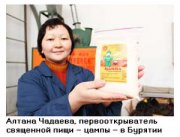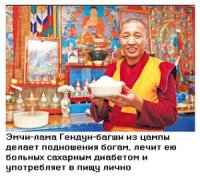 On the eve of Sagaalgan, a family couple from Ulan-Ude are releasing into production a unique product - tsampa. This food, made by a special technology based on ancient recipes of nomadic people, will now become freely available. To release this "food of the gods" into mass production involved a long journey.
On the eve of Sagaalgan, a family couple from Ulan-Ude are releasing into production a unique product - tsampa. This food, made by a special technology based on ancient recipes of nomadic people, will now become freely available. To release this "food of the gods" into mass production involved a long journey.
Buryat muesli
Tsampa, talkan, Tibetan fast-food, Buryat muesli, talkanella - there are many names for this food. But in any case, this food is unknown to the majority of residents of this republic. But for Altana Chadayeva, the taste of tsampa is a taste known and familiar since childhood. She was born and grew up in Altai, where this food is considered a national dish.
Having married a Buryat and coming to our republic (Buryatia), Altana continued to cook this dish following her grandmother's old recipe even here. And everything had to be done, just like in her native country, by hand. However, the results exceeded her expectations. Friends and family of Altana and Bazyr Dondokov, her husband , who tasted tsampa by chance wanted to get some for themselves. So the circle of tsampa lovers kept growing. Gradually things came to such a pass that Altana started selling talkan made by her own hands for a symbolic price. When the sales reached several hundred kilograms in a month, the idea spontaneously originated - to start mass production.
Naturally, to make talkan by hand is very tiring and complicated. Barley grains have to be cleaned, roasted, pounded, winnowed, and milled in mills, and so on. The obstacle consisted of the fact that such equipment for making tsampa does not exist even in a dream. And money was needed to buy and remodel equipment which was even just remotely suitable. The couple decided to take part in a republican contest "Biznes-start", and to their own surprise, they won the contest, and received government support of 300 thousand rubles. Now the work could move on.
- We did not expect that we'd win. I am a philologist-folklorist by education specialty and far from commerce and business. Thanks to my husband, we got to take part in such a contest. I simply told him in my own words how I want to do all this, about the process of making tsampa, and he translated it into the trade language, - Altana Chadayeva explains.
So the family business got its foundation. They worked up the ideas, how to automatize almost all the processes, bought the equipment and altered it as necessary, they hired the workers, and then the longest, most complicated stage - certifications and permit documentation for the production - was completed. Now they could come out on the market.
They even thought out the name of the new product - "Food of nomads".
- Tsampa was made since old times by the Bashkirs, and Tuvans, and Buryats, and Altaians - in one word, by all the nomadic peoples. That is why I thought of this name, - Altana explains. - Even though few people in Buryatia eat tsampa nowadays, maybe a few old grandmothers in the villages., who preserved the recipes of their grandmothers.
The History
The history of this product is interesting. Tsampa is over one thousand years old! In Tibet, this dish existed since time immemorial and has always been considered sacred - "food of the gods". It is revered by Tibetan lamas to this day. Tsampa was especially indispensable during periods of retreat, when a lama would go into meditation for a long time, secluding himself from the outside world. Supposedly some lamas can stay completely without food for weeks during these periods , being nourished only by the aroma of tsampa.
The ritual of scattering tsampa originated already in pre-Buddhist times, and served to propitiate the local spirits, and to ask for their protection and favor. Later the custom was adopted by Buddhism as a "symbol of joy and celebration". Buryat lamas, just like Tibetan ones, use tsampa in rituals and for making balin - offerings to the gods. True, most often they have to do it with a simplified substitute - they roast ordinary wheat flour and make the offerings from the dough.
But during Genghis Khan's time, hunters used to take only tsampa along as food; they carried it in leather pouches, and went off - for several days of hunting. In the forest they would pour the tsampa into a bowl, add water from a stream, and there it was - food - filling and compact.
Healthy fast food
The majority of tsampa lovers, who can't even imagine their life without this product, value it precisely for this - ease of cooking and healthy qualities. To simplify, tsampa is flour made from lightly roasted barley grains, even though the consistency is not really flour-like. And it contains many times more valuable substances than ordinary flour.
 - We get rid of the husks, but then we process the grains in a careful way, it has to be balanced, the consistency should not be like flour, but it should not be too coarse either, that is why we had to alter all the equipment, to change things here and there, - Bazyr Dondokov says.
- We get rid of the husks, but then we process the grains in a careful way, it has to be balanced, the consistency should not be like flour, but it should not be too coarse either, that is why we had to alter all the equipment, to change things here and there, - Bazyr Dondokov says.
In the opinion of the couple, even though the product is made with use of automatization, it should not differ in any way from the same tsampa as it was made by our ancestors. And the creators of the new product are confident that nothing is more convenient as a breakfast for the whole family.
- Tsampa is especially irreplaceable for people who are on a very busy schedule, - says Altana. - You put a teapot on boil in the morning, pour water on the tsampa, add cream and sugar, and it is ready! And at the same time it is completely natural, nourishing and healthy. And for those who are afraid of gaining weight, it is completely harmless. It is not by chance that tsampa is called "Buryat muesli", - says Altana.
The flavor of the dish prepared in this way is reminiscent of yogurt or delicate cottage cheese with a taste of roasted barley. The flavor is at first unusual, but spoonful after spoonful - and it is impossible to stop. Tsampa is the base, and the recipes for making various dishes from it are many. You can make flat fried cakes from it, you can thicken Buryat tea with it, and you can make something like yogurt or porridge.
And if you realize that this product cleanses the organism, improves the peristalsis of the digestive tract, draws waste and toxins out of the body, you can actually call it priceless.
- The lamas had good reasons to consider tsampa a sacred food - it is not very heavy and it has healing properties. This 100% natural product contains everything that the organism needs: proteins and carbohydrates, in a proportion that is optimal for correct absorption by the body important microelements (zinc, magnesium, iron, calcium, copper, selenium and others), and also vegetable fiber, - insists Altana.
Tsampa normalizes the acid-base balance of the blood, helps dissolve cholesterol and salt deposits in blood vessels, in joints, in the vertebral column, kidneys and liver. Tsampa is good for elderly people, because it strengthens bones, and those who have arthritis improve. Tibetan medicine recommends eating tsampa for diabetes mellitus, anemia, kidney disease, vitamin deficiencies, back pain, loss of male potency, chronic lung disease, and for people with senile dementia.
Buryat cakes
The new type of newborn businessmen should produce and release about a ton of tsampa every month. There are plans for making tsampa with various additions.
- For example, we could make "talkanella". That is a tsampa ball with almonds inside, like like the famous "Rafael balls". We could also add anise, raisins, make cookies, cakes - there are many possibilities, - plans Altana.
Tsampa will not be expensive - about 80 rubles per kilogram of the mixture. At first, the product will be sold in datsans of Ulan-Ude, and later in widespread distribution.

